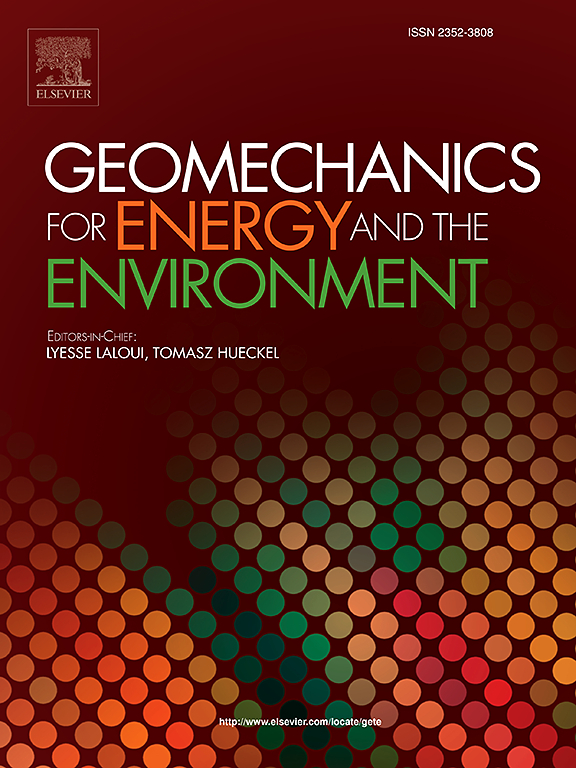利用动态压痕实验量化模拟冲击钻孔过程中消耗的能量
IF 3.3
2区 工程技术
Q3 ENERGY & FUELS
引用次数: 0
摘要
钻探深井的高昂成本是广泛开发深层地热能源的主要障碍。冲击钻井是能源勘探项目中使用的重要钻井技术之一。然而,对于冲击钻在粉碎、加热、颗粒动能、声发射等方面消耗了多少能量,目前还没有很好的定量了解。本研究对能效进行了定量研究,以更好地了解冲击钻的钻进过程。使用改进的分体式霍普金森压力棒(SHPB)系统和非接触式测量方法对动态冲击钻进进行了评估。估算了库鲁花岗岩、巴尔莫勒尔花岗岩和基维耶尔维辉长岩在不同过程中耗散的能量以及总体能量效率。使用高速照相机评估了碎片动能 Ek 消耗的能量,而热量或热能 Et 消耗的能量则是通过高速红外成像获得的。裂解能 Ec 是通过岩石表面能和新产生的总表面积来测量的。结果表明,这三种岩石的碎裂尺寸分布一般随穿透速度而变化,岩石的碎裂程度随穿透速度而增加。输入能量和能量消耗随着穿透速度的增加而增加。在这三种岩石的总能耗中,Et、Ek 和 Ec 所占的比例随着穿透速度的增加而增加。这三种岩石的动态压入实验所获得的能量效率一般随穿透速度的增加而增加,当穿透速度较高时,能量效率几乎接近极限值。改进的模型可以定量描述能量效率与贯入速度之间的关系。因此,应优化贯入过程,以兼顾高钻进效率和低能耗。本文章由计算机程序翻译,如有差异,请以英文原文为准。
Quantification of energy consumed in simulated percussive drilling process using dynamic indentation experiment
The high cost of drilling deep wells is the main barrier to the widespread exploitation of deep geothermal energy. Percussive drilling is one of the significant drilling technologies used in energy exploration projects. However, there is no good quantitative understanding of how much energy in percussive drilling is consumed in pulverization, heating, the kinetic energy of particles, acoustic emission, etc. In this study, energy efficiency is quantitatively investigated to understand the percussive drilling process better. The dynamic percussive drilling was evaluated using a modified split Hopkinson pressure bar (SHPB) system and non-contact measurements. The amount of energy dissipated in different processes and the overall energy efficiency was estimated for Kuru granite, Balmoral granite, and Kivijärvi gabbro. The energy spent on the kinetic energy Ek of fragments was evaluated using a high-speed camera, whereas the energy consumed on heat or the thermal energy Et was obtained by high-speed infrared imaging. The cracking energy Ec was measured by using the surface energy of rock and the total newly created surface areas. The results indicate that the fragment size distribution of these three rocks generally varies with the penetration speed, and the fragmentation level of these rocks increases with the penetration speed. The input energy and the energy consumption grow with the increase of the penetration speed. The proportions of Et, Ek, and Ec in the total energy consumption for these three rocks increase with the penetration speed. The energy efficiency obtained from the dynamic indentation experiments for the three rocks generally increases with the penetration speed and almost approaches a limit value when the penetration speed is high. A model is improved to describe the relationship between energy efficiency and penetration speed quantitatively. Therefore, the penetration process should be optimized to balance the high drilling efficiency and the low energy consumption.
求助全文
通过发布文献求助,成功后即可免费获取论文全文。
去求助
来源期刊

Geomechanics for Energy and the Environment
Earth and Planetary Sciences-Geotechnical Engineering and Engineering Geology
CiteScore
5.90
自引率
11.80%
发文量
87
期刊介绍:
The aim of the Journal is to publish research results of the highest quality and of lasting importance on the subject of geomechanics, with the focus on applications to geological energy production and storage, and the interaction of soils and rocks with the natural and engineered environment. Special attention is given to concepts and developments of new energy geotechnologies that comprise intrinsic mechanisms protecting the environment against a potential engineering induced damage, hence warranting sustainable usage of energy resources.
The scope of the journal is broad, including fundamental concepts in geomechanics and mechanics of porous media, the experiments and analysis of novel phenomena and applications. Of special interest are issues resulting from coupling of particular physics, chemistry and biology of external forcings, as well as of pore fluid/gas and minerals to the solid mechanics of the medium skeleton and pore fluid mechanics. The multi-scale and inter-scale interactions between the phenomena and the behavior representations are also of particular interest. Contributions to general theoretical approach to these issues, but of potential reference to geomechanics in its context of energy and the environment are also most welcome.
 求助内容:
求助内容: 应助结果提醒方式:
应助结果提醒方式:


